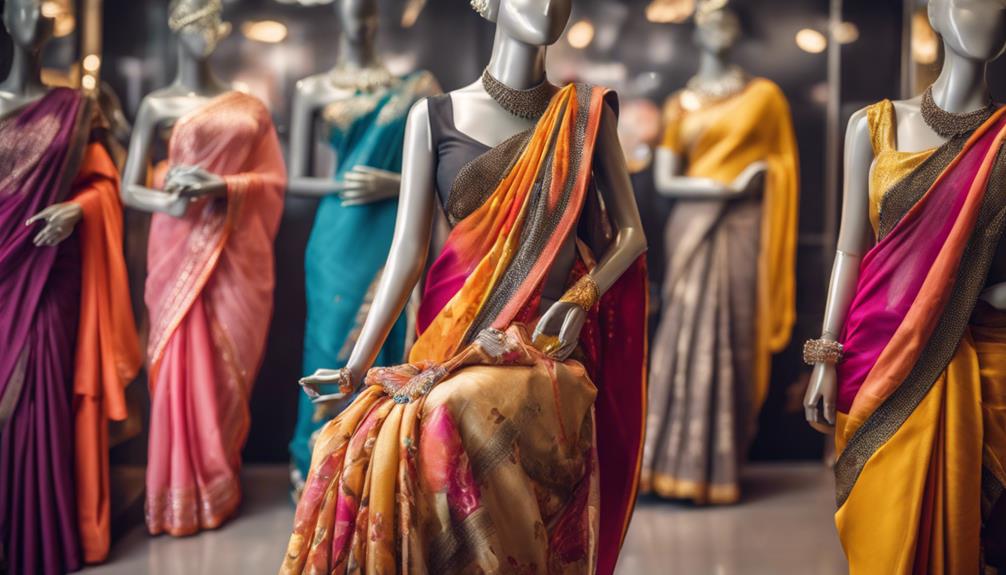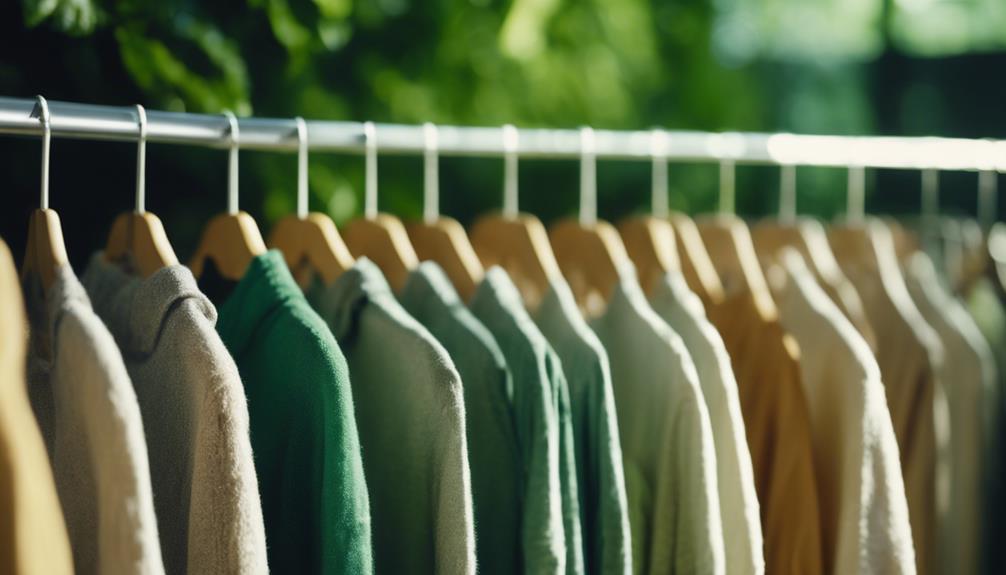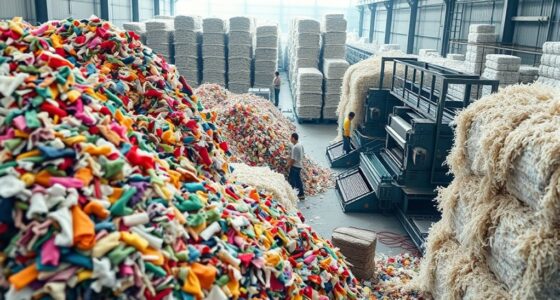Sustainable fashion introduces various innovative approaches that transform the way you perceive clothing. You will encounter ethical fashion, which ensures fair labor practices and safe working conditions. Additionally, there is slow fashion, which emphasizes timeless pieces to reduce waste and promote mindful consumption. Circular fashion transforms trash into treasures through recycling and upcycling, while conscious fashion encourages informed purchases that are in line with your values. Each of these approaches plays a vital role in reducing the environmental impact of the fashion industry. Interested in learning more about these trends and their advantages? Keep exploring to find out how you can contribute to making a positive impact!
Key Takeaways
- Ethical Fashion ensures fair labor practices and safe working conditions for garment workers, promoting transparency and worker welfare in the industry.
- Slow Fashion emphasizes quality over quantity, encouraging consumers to invest in timeless, durable pieces that reduce waste and promote mindful consumption.
- Circular Fashion focuses on recycling, upcycling, and thrifting to extend garment life, minimizing waste and fostering sustainable consumption habits.
- Conscious Fashion encourages informed purchasing decisions, supporting eco-friendly brands and practices while reducing the negative impact of fast fashion.
Understanding Sustainable Fashion
Sustainable fashion is all about making responsible choices that prioritize ethical practices and environmental consciousness in the clothing industry. You're likely aware of the sustainable fashion movement, which encourages a shift from fast fashion to more thoughtful consumption. This movement promotes ethical fashion brands that focus on fair labor practices and safe working conditions for everyone involved in the supply chain.
One key aspect is the circular economy, which emphasizes recycling and upcycling to minimize waste. By choosing to thrift or repurpose clothing, you contribute to a system that reduces the environmental impact of textile production.
Slow fashion also plays a crucial role, urging you to invest in high-quality, timeless pieces that last longer, rather than succumbing to fleeting trends.
Conscious fashion asks you to be aware of your choices and opt for eco-friendly products. By supporting brands committed to sustainability, you help drive demand for practices that prioritize the planet.
Understanding these principles not only empowers you as a consumer but also fosters a more responsible industry that values both people and the environment.
Key Areas of Sustainable Fashion

Understanding the key areas of sustainable fashion can help you make informed choices that align with your values and promote a more responsible industry.
One essential aspect is ethical fashion, which guarantees fair labor practices and safe working conditions throughout the supply chain. By supporting ethical brands, you contribute to addressing child labor and gender discrimination in garment production.
Another notable area is slow fashion, which emphasizes quality and longevity over the rapid production cycles of fast fashion. By investing in timeless pieces, you not only reduce waste but also promote mindful consumption.
Circular fashion plays a significant role too, focusing on recycling, upcycling, and thrifting to extend product lifespans and minimize waste. This approach encourages you to rethink your consumption habits and embrace sustainability.
Lastly, conscious fashion pushes you to support eco-friendly products and sustainable brands that prioritize responsible practices. By being aware of these key areas, you can meaningfully reduce your environmental impact while fostering a culture of ethical consumerism in the fashion industry.
Every choice you make contributes to a better, more sustainable future.
Importance of Ethical Fashion
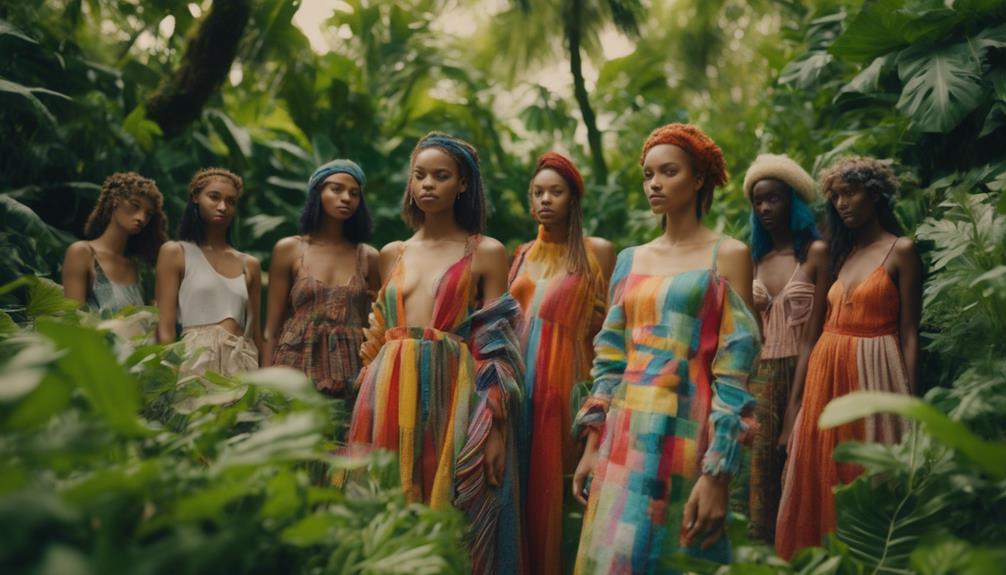
When you choose ethical fashion, you're supporting fair trade practices that prioritize worker welfare and safe working conditions.
You play an essential role in promoting ethical production methods that can transform the fashion industry.
Fair Trade Practices
Fair Trade practices play an essential role in transforming the fashion industry by ensuring garment workers earn living wages and work in safe conditions. By promoting ethical and sustainable practices, Fair Trade initiatives address the exploitation often associated with fast fashion. This certification program enhances transparency in supply chains, allowing you to identify brands that prioritize social responsibility.
With approximately 300 million people employed in the global garment industry, many face significant human rights violations. Fair Trade is critical in improving their livelihoods, ensuring they receive fair compensation and work in environments that respect their rights. Additionally, Fair Trade practices invest a portion of profits back into the communities where these workers live, promoting sustainable economic growth.
While brands adhering to Fair Trade standards may incur higher production costs, your willingness to pay a bit more for ethically produced clothing makes a difference. Supporting these practices not only empowers garment workers but also fosters a fashion industry that values people over profit.
Worker Welfare Importance
Worker welfare is essential in ethical fashion, as it guarantees that individuals involved in garment production receive fair wages and work in safe environments. By prioritizing worker welfare, ethical fashion advocates for human rights, ensuring that every worker is treated with dignity and respect.
Unfortunately, many garment workers, particularly in places like Bangladesh, earn as little as $80 per month while enduring long hours. This highlights the urgent need for reforms that align with the Fair Labor Standards Act.
Ethical fashion practices help eliminate human rights violations like child labor, modern slavery, and gender discrimination. Supporting brands committed to ethical labor practices means you're contributing to a movement that seeks to eradicate these injustices.
Certifications like SA8000 and B-Corporation serve as guides, reassuring you that brands prioritize living wages and safe working conditions.
Documentaries like 'The True Cost' further illustrate the harsh realities faced by garment workers, making it clear that your choices matter. By choosing ethical fashion, you're not just buying clothes; you're advocating for a system that respects worker welfare and promotes fairness in the global fashion industry.
Ethical Production Methods
Ethical production methods are vital for creating a fashion industry that not only respects workers' rights but also promotes sustainable practices throughout the supply chain. By focusing on fair labor practices, you're supporting an environment where garment workers receive living wages and work in safe conditions. This commitment to worker welfare guarantees that your clothing choices contribute positively to the lives of those who make them.
Moreover, transparency in supply chains is essential. When you know the origins of your clothing, you can better understand the labor conditions involved in its creation. Many brands are now taking steps to improve their transparency, driven by consumer demand for ethical practices. However, the Fashion Revolution Transparency Index revealed an average score of only 24% among major brands in 2022, highlighting a significant gap in ethical production.
It's clear that while adopting ethical production methods can increase costs for brands, the shift towards fair labor initiatives is gaining traction. By choosing ethically produced fashion, you're not just making a style statement; you're advocating for a more just and sustainable industry that prioritizes the rights and welfare of workers everywhere.
Circular Fashion Explained
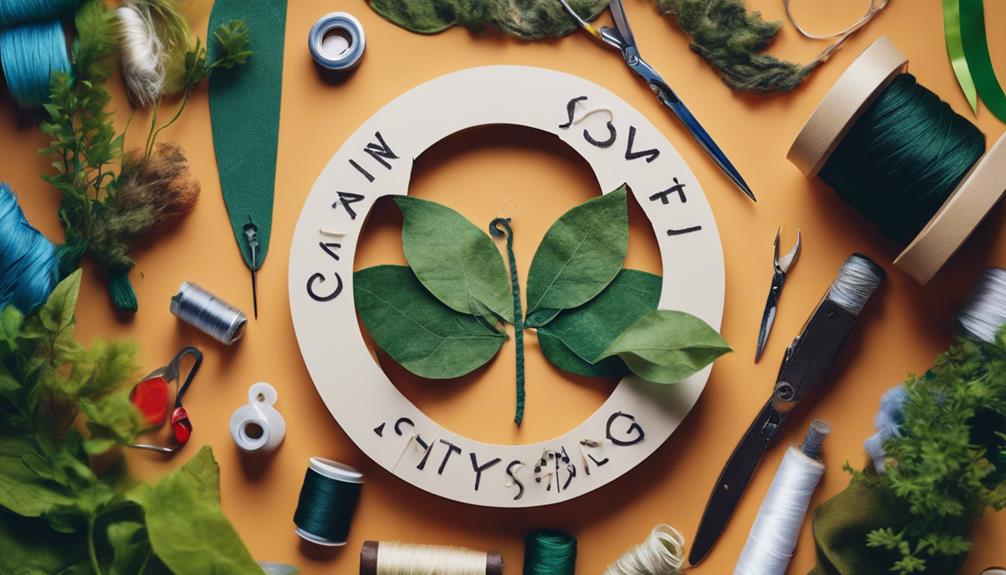
Circular fashion is all about creating a system where clothes are designed to last, be reused, and eventually recycled.
You'll discover how adopting these practices can greatly benefit the environment and the economy.
Let's explore key strategies that make circular fashion a game-changer in the industry.
Definition of Circular Fashion
To summarize, circular fashion is a sustainability model designed to extend the life of garments by prioritizing reuse, recycling, and minimizing waste throughout their entire lifecycle. This approach not only benefits the environment but also encourages you to rethink your relationship with clothing.
Here are three key aspects of circular fashion:
- Longevity: By opting for durable materials, you can considerably reduce the frequency of purchases, leading to less waste in landfills.
- Upcycling: Transforming old garments into new products not only breathes new life into your wardrobe but also diminishes the demand for new resources.
- Closed-loop systems: Many brands now implement programs that reclaim used garments, recycling them into new fibers, which helps address the staggering 60% of clothing that ends up in landfills annually.
Circular fashion emphasizes the importance of recycling and using materials that can be easily processed after their lifecycle.
Benefits of Circular Practices
Embracing circular practices not only helps the environment but also provides numerous benefits for consumers and brands alike. By engaging in circular fashion, you actively participate in recycling and upcycling, which markedly reduces textile waste. When you extend the lifecycle of your garments, you can decrease environmental impacts by up to 30%, all from just nine additional months of use.
Circular practices encourage brands to adopt sustainable practices, such as designing for disassembly and utilizing biodegradable materials. This shift can lead to lower carbon footprints, making your fashion choices more eco-friendly.
Additionally, community initiatives like clothing swaps and rental services promote a culture of sharing and reusing. By participating in these activities, you reduce individual consumption while making sustainable fashion choices.
You also play an essential role in mitigating the staggering 21 billion tons of textile waste generated annually. When you choose circular fashion, you're not just making a style statement; you're contributing to a healthier planet.
Key Circular Fashion Strategies
Focusing on extending the lifecycle of garments, key circular fashion strategies include recycling, upcycling, and thrifting to greatly cut down on textile waste and lessen environmental impact. By adopting these practices, you can play an essential role in promoting sustainability.
Here are three effective strategies to reflect on:
- Recycling: Participate in take-back programs that allow brands to reclaim used clothing, repurpose materials, and minimize reliance on new resources.
- Upcycling: Transform old garments into new, stylish pieces, turning waste into wearable art while promoting resource conservation.
- Clothing Swaps: Engage in community-based initiatives that encourage sharing and reusing garments, reducing your individual consumption and fostering connections around sustainability.
Additionally, by emphasizing durability and repairability in clothing design, brands can greatly prolong the life of their products. Extending clothing use by just nine months can reduce environmental impact by over 30%.
Embracing these circular fashion strategies not only benefits your wardrobe but also contributes to a more sustainable and eco-friendly future. So, why not immerse yourself and make a difference today?
The Concept of Slow Fashion

Slow fashion champions quality and sustainability, urging you to invest in timeless pieces that last longer and reduce your environmental footprint. This movement emphasizes the importance of mindful consumption, encouraging you to choose fewer, high-quality items instead of getting caught up in the fast fashion cycle.
Sustainable fashion brands that align with this philosophy focus on ethical sourcing and fair labor practices, ensuring that their production methods consider both the environment and the people involved.
By embracing slow fashion, you can markedly decrease your environmental impact. Studies show that extending the lifespan of your clothing by just nine months can reduce waste and pollution by up to 30%. The slow fashion approach promotes versatile designs and minimalist wardrobes, helping you prioritize sustainability and intentionality in your clothing choices.
In a world where trends come and go, slow fashion advocates for the appreciation of quality and longevity in your wardrobe. By being more selective about what you buy, you not only support ethical practices but also contribute to a healthier planet.
Conscious Fashion Practices

Conscious fashion practices encourage you to make informed choices that support eco-friendly products and brands. By embracing these practices, you can actively participate in the movement against the fast fashion industry and its detrimental effects on our planet.
Here are three key actions to reflect on:
- Research Sustainable Clothing Brands: Explore brands that prioritize sustainability and ethical practices. Consumers must scrutinize their claims to guarantee their purchases truly reflect your values.
- Thrift and Upcycle: Instead of buying new, explore thrift stores or upcycle existing garments. This not only reduces waste but also adds a unique touch to your wardrobe.
- Participate in Clothing Swaps: Join or organize clothing swaps with friends or community members. This fosters engagement while extending the lifecycle of garments.
Environmental Impact of Fashion

Understanding the environmental impact of fashion is essential for making responsible choices in your wardrobe. The fashion industry contributes a staggering 10% to the global carbon footprint, intensifying climate change and environmental degradation.
Conventional cotton farming is particularly harmful, as it accounts for 25% of the world's insecticides and 18% of pesticides. This reliance on synthetic chemicals poses serious risks to ecosystems and human health.
Moreover, global cotton production isn't just about the crops; it's about water too. Producing a single pair of jeans requires nearly 2,000 gallons of water, which heightens the negative impact on our already strained water resources.
Fast fashion exacerbates this issue, leading to a staggering 80 billion pieces of clothing consumed annually and generating 21 billion tons of textile waste each year.
Switching to organic cotton and other sustainable fabrics can appreciably reduce the environmental impact of your wardrobe. By choosing eco-friendly options, you contribute to a healthier planet and help mitigate the harmful effects of the fashion industry.
It's time to make informed choices that reflect your values and protect our environment for future generations.
Innovations in Sustainable Fashion

Innovative solutions in sustainable fashion are transforming the industry, making it easier for you to choose eco-friendly options without sacrificing style.
Here are three exciting innovations shaping the future:
- Recycled Materials: Brands like Patagonia and Adidas are leading the charge by using recycled polyester and ocean plastics, respectively, greatly reducing waste and resource consumption.
- Plant-Based Leathers: Alternatives like Piñatex, made from pineapple leaves, repurpose agricultural waste and offer a cruelty-free alternative to traditional leather, showcasing what sustainable means.
- Waterless Dyeing: New technologies can cut water usage by up to 90% compared to conventional dyeing methods, minimizing environmental impact.
These innovations in sustainable fashion not only enhance your wardrobe but also support a healthier planet.
Additionally, circular fashion concepts, such as clothing rental and subscription services, allow you to enjoy variety without contributing to waste and overconsumption.
With these advancements, you can confidently make choices that align with your values while still looking stylish.
Embracing these innovations guarantees you're part of a movement that prioritizes sustainability and creativity in fashion.
Frequently Asked Questions
What Are the 4 R's of Sustainable Fashion?
The 4 R's of sustainable fashion are Reduce, Reuse, Recycle, and Repair. By prioritizing quality, reusing items, recycling materials, and repairing clothes, you can greatly lower your environmental impact and promote a more sustainable wardrobe.
What Are the 7 Rs of Sustainable Fashion?
The 7 Rs of sustainable fashion are game-changers! You can refuse, reduce, reuse, repair, recycle, rent, and redesign. Embracing these principles transforms your wardrobe and helps protect our planet from overwhelming waste.
What Are the 5 Rs of Sustainable Fashion?
The 5 Rs of sustainable fashion are Refuse, Reduce, Reuse, Recycle, and Rot. By incorporating these principles into your wardrobe choices, you can actively contribute to a more sustainable fashion industry and minimize your environmental impact.
What Does Sustainable Fashion Mean?
Sustainable fashion means weaving a tapestry of ethics and eco-friendliness into your wardrobe. It's about choosing garments that respect the planet and its people, ensuring your style leaves a lighter footprint on the Earth.
Conclusion
In exploring the various types of sustainable fashion, it's clear that each approach plays a crucial role in reshaping the industry. Some sustainable fashion examples include upcycling and using eco-friendly materials. Upcycling involves taking existing materials and transforming them into new clothing or accessories, reducing the need for new resources. Utilizing eco-friendly materials, such as organic cotton or recycled polyester, helps minimize the environmental impact of fashion production. Overall, these various approaches to sustainable fashion work together to promote more ethical and responsible practices within the industry.
By embracing practices like circular and slow fashion, you're not just making a style statement; you're contributing to a healthier planet.
Isn't it time we all considered the impact of our fashion choices?
By prioritizing ethical and innovative solutions, you can help pave the way for a more sustainable future in fashion.

